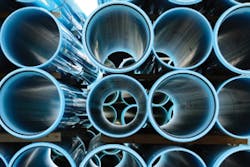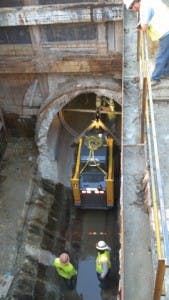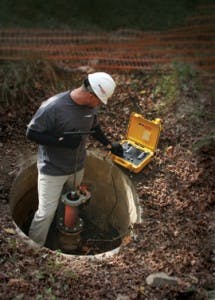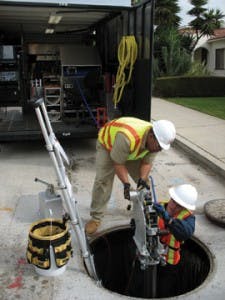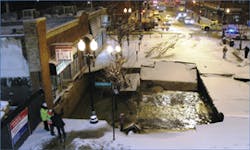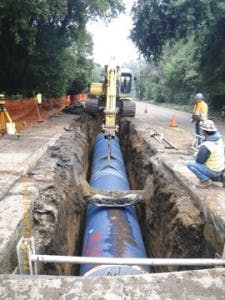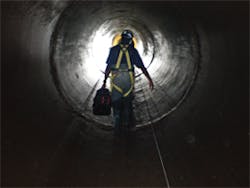December declared war on water pipes.
Early in the month, three water main breaks in San Diego County, CA, created sink holes that closed roads. Residents were without water and plumbing in several districts while crews rushed to repair water mains and roadways.
A San Diego Water Department spokesperson told Fox 5 news that water main breaks were occurring more frequently as the life expectancy of the cast iron pipes expired. The 6-inch water main in North Park was 61 years old. Replacement has been slow due to the complexity of the work and the cost, but the Department hopes to have them all replaced by 2017.
Later that month, the Press Herald reported a cast-iron, 20-inch water main break that flooded a Portland, OR, neighborhood, disrupting 4,000 homes and businesses, causing property damage, and prompting boil orders. The century-old pipe isn’t even the city’s oldest; some lines date back to the late 19th century.
December declared war on water pipes. Early in the month, three water main breaks in San Diego County, CA, created sink holes that closed roads. Residents were without water and plumbing in several districts while crews rushed to repair water mains and roadways. A San Diego Water Department spokesperson told Fox 5 news that water main breaks were occurring more frequently as the life expectancy of the cast iron pipes expired. The 6-inch water main in North Park was 61 years old. Replacement has been slow due to the complexity of the work and the cost, but the Department hopes to have them all replaced by 2017. Later that month, the Press Herald reported a cast-iron, 20-inch water main break that flooded a Portland, OR, neighborhood, disrupting 4,000 homes and businesses, causing property damage, and prompting boil orders. The century-old pipe isn’t even the city’s oldest; some lines date back to the late 19th century. [text_ad] [caption id="attachment_1372" align="alignright" width="169"]Norvin Eitzen of Pure Technologies warns, “As water and sewer infrastructure deteriorates, the likelihood of leaks and pipeline failures increase, which can impact service reliability.”
The Portland Water District experiences an average of 100 breaks per year, which is a 30% decrease in the past decade, thanks in part to the implementation of a water main improvement program in 1985.
Replacing everything at once would cost an estimated $630 million, according to Michelle Clements, public relations manager for the District that serves Portland and 10 surrounding communities; so roughly $3 million is budgeted annually to gradually replace more than 1,000 miles of old pipes. Replacement decisions are based on the age of the pipe, history of breaks, and customer complaints.
Despite several incidents, December wasn’t an unusual month. Countless stories of broken pipes, flooding, property damage, and outages make headlines across the country almost every month as municipalities cope with the consequences of an aging pipe network suffering from leaks, low pressure, tuberculation, infiltration, and collapse. For example, last summer a 103-year-old, 42-inch cast iron pipe broke in Boston, MA. Subsequent flooding ruined many books at the Boston Public Library.
The repercussions of a break can reach beyond costly repairs of pipes and roads to include property damage, lost business, and health risks.
“As water and sewer infrastructure deteriorates, the likelihood of leaks and pipeline failures increase, which can impact service reliability and result in massive financial costs,” says Norvin Eitzen of Pure Technologies. The ramifications extend beyond monetary issues. “It also erodes public confidence in the utility and can pose serious environmental concerns that lead to consent decrees and legal action from the government.”
Even if pipes aren’t breaking, they might not be providing adequate flow or pressure, due to faulty joints or pinholes created by corrosion. Tuberculation leads to poor water quality, producing dissatisfied customers as it reduces utility profits.
Many Public Works professionals understand that tracking pipe connections is key.
Age Before Beauty
“Aging infrastructure across North America presents a challenging problem for utility owners,” says Eitzen. “Many pipeline systems are reaching or are already at the end of their intended design life.”
According to Norm Lamie, chief engineer for the Maine Drinking Water Program, the typical lifespan of cast iron water mains is 75–125 years, depending on pipe material, installation, soil type, and other environmental factors.
“The problem is huge and growing, because the infrastructure continues to age, [but] the dollars we invest into the problem [are] decreasing,” states Kimberly Paggioli, P.E., and vice president of Marketing and Quality Control with HOBAS Pipe USA.
Budgeting to fix the infrastructure problem is a problem in itself.
“Water and wastewater infrastructure, specifically, is one area noted by industry organizations that will require significant funding in the coming decades,” says Eitzen. “Industry studies estimate that $1 trillion will be needed over the next 25 years for updating and expanding America’s water infrastructure, and that there is a huge funding gap present between what is needed and what is fiscally possible. This problem is exacerbated by the fact that capital budgets are very tight and utility operators must compete with other public projects for the funding they need to rehabilitate infrastructure.”
As Lamie told the Press Herald, industry standard dictates replacing 1% of a municipality’s pipes per year. However, funding doesn’t always allow that. The Maine program provides money to water districts on an “application basis.” It’s expected to distribute $13 million for new infrastructure this year.
A Drinking Water Infrastructure Needs Survey conducted by EPA, per Safe Drinking Water Act requirements indicated that the largest infrastructure need is for installation and rehabilitation of transmission and distribution systems. Municipalities expected to spend $77.2 billion over the next 20 years to address the problem.
“Hopefully,” says Paggioli, “over the next few years, the municipalities will find ways to fund investment in all infrastructure, but, especially those that have been ‘out of sight.’”
Wear and Tear
As many public works engineers know, 50-, 60-, and 70-year-old pipes are breaking regularly, not because they “wear out” or lose strength—after all, many water mains constructed are cast iron pipes—but because they corrode.
According to EPA, corrosion caused by hydrogen sulfide gas or other sources of acid is the most frequent cause for pipe deterioration and can cause materials to fail in as little as 10 years. One EPA survey revealed that 32 of 89 cities reported sewer collapses, most due to hydrogen sulfide corrosion. It’s caused by low velocities in a sewer line, long detention times, and high temperatures in the pipe.
In addition to corrosion, large-diameter pressure pipe failure can be caused by cracking or wire breaks, Eitzen indicates. Damage can be caused by external factors, such as soil conditions or movement, stray electrical currents in the surrounding soil, the presence of toxic materials such as metals that reduce bacterial activity, turbulence, improper installation, and even construction activity. Internal conditions such as operating pressure and gas pockets can also contribute to failure.
Infrastructure repair and rehabilitation efforts are large-scale Public Works projects that can disrupt communities and pack a hefty price tag.
Pipes need to be rehabilitated for one of two reasons, Paggioli states.
“Either they have severe enough corrosion to cause structural defects in the line, compromising integrity, or they have lost their sealing ability . . . from joint leaks or structural cracks in the pipe.”
Compromised sealing ability allows infiltration into the line, which can lead to potential environmental issues. In extreme cases, leaking joints permit permeation by surrounding soil, which compromises the pipe embedment, leading to further degradation.
As stated above, most issues are due to corrosion, poor material choices, or poor installation practices. A recent explosion in Chicago illustrates the results when the wrong material is used. Prestressed concrete cylinder pipe manufactured in the 1970s was used extensively, but there were issues with the material and design.
There is speculation that because the initial project involved used a small-diameter wire less than 1/8th of an inch, that wire was setup to fail. And when it did finally give, an engineer familiar with the project declared that the noise sounded like dynamite exploding. Crews had to replace and repair pipes with carbon fiber before putting put tendons around them to reduce the stress on the pipes. Because concrete is strong in compression, weak in tension, the wires keep it in compression. Uncovering the pipeline in heavy urban areas required very expensive specialized construction.
The consequences of digging up and replacing pipe include disrupting traffic, and because sometimes gas, fiber optic, and sewer lines are in the way, a 60-inch pipeline can result in a big hole and a huge mess.
Cases like these are what spurred a huge industry to begin pipe assessments, and though more often than not, less than 5% of conveyance systems may have issues—in order to avoid huge catastrophes, engineers advise utilities to check them all.
Assessment
Most pipes, such as cast iron, weep; they don’t blow up. Nevertheless, because old lines develop small leaks that can go unnoticed for a long time, spilling billable product, it’s necessary to check them too. Therefore, many companies conduct asset management.
If they don’t, they should. As Eitzen explains, “Because aging pipeline infrastructure is a widespread problem, it is important for utilities to complete regular condition assessment projects to identify pipeline risk and then use this information to create a prioritized rehabilitation plan.”
He goes on to say that utilities can mitigate the effects of corrosion and other problems by identifying the most distressed areas and selectively renewing the sections that pose the most risk.
Pure Technologies, based in Calgary, AB (Canada), is an infrastructure management firm specializing in the development and application of technologies designed for inspecting, monitoring, and managing water and wastewater systems.
“While Pure does not rehabilitate pipelines specifically, we work closely with utilities to identify pipe sections that require rehabilitation and guide them through the process,” explains Eitzen.
The company helps utilities manage their infrastructure as it ages by providing pipeline education, engineering services, and pipeline inspection and monitoring. Creating a comprehensive pipeline management program that includes leak detection and condition assessment allows utility operators to identify which areas of their system are at highest risk and selectively rehabilitate specific pipe sections through repair or replacement.
“Through years of work and data collection, we have found that a large percentage of pipelines are in ‘like new’ condition and do not need immediate attention, meaning utilities can save huge and unnecessary capital costs by managing their existing system in favor of replacing it,” notes Eitzen. After providing a baseline condition, Pure Technologies can track deterioration as it occurs.
Presenters at the 2006 Municipal Sewer & Water Trenchless Workshop in San Antonio, TX, suggested an assessment checklist that includes evaluating water quality and structural condition; noting leakage, repair, and maintenance history; and checking existing hydraulics and needed system upgrades.
Based on the data collected, the utility should develop a water main rehabilitation strategy by selecting the appropriate technology for use within identified parameters that include water main location, material type, and service condition; the physical environment; utility needs and budget; and community impact.
New technologies can help detect possible vulnerabilities before a big pipeline failure occurs.
Plan of Attack
After assessing the extent of the problem, it’s time to decide whether to repair or replace the pipe, and with what material. With distribution lines, leaks are located, and the thickness of the pipe is measured to calculate a solution. Distribution is the most critical piece, but with transmission line failure, the consequences are huge. Ultimately, the decision often comes down to cost and budget: When determining the extent to which a repair is needed utilities are often left deciding between a “Band-Aid” that could last five to 10 years, or investing in a more permanent solution. Unfortunately, the decision is usually influenced by budget—as is so often the case, it comes down to money.
To keep up with necessary upgrades to its aging infrastructure, in 2010, Denver Water implemented a maintenance program to increase the amount of rehabilitation of its cast iron pipes each year, with a goal of rehabilitating 50,000 feet per year. In addition to cleaning and lining pipes, they add and replace valves in order to maintain water quality and ensure adequate flow. Recognizing that rehabilitating old pipe with cement mortar lining is less expensive and disruptive, Tom Roode, director of operations and maintenance, also realizes that not all pipes are candidates for rehabilitation, so the utility also has a proactive replacement program in place.
Eitzen says price is one of the factors in the recommendations proffered by Pure Technologies.
“Typically, cost, the complexity of the repair work, and the risk associated with the damaged pipe sections are taken into consideration when writing recommendations for rehabilitation schedules.”
However expensive a repair is, the alternative is equally costly. While Paggioli considers it difficult to quantify, she says that infiltration into the sewer adds to treatment costs. “Additionally, the leaks may cause other associated structural deficiencies, due to undermining of pipe support.”
Heavy infiltration can cause higher flows during wet weather events.
Because most infrastructure is buried, leaks can sometimes go undetected for years. Eitzen says that leaks that are unknown or ignored for an extensive period of time can be “extremely costly.” For example, a quarter-inch hole in a pipeline operating at 100 psi would leak nearly 8 million gallons of water per year.
Eitzen adds, “While more leaks are typically found in small-diameter distribution systems, leaks on large-diameter transmission mains account for significantly more water loss, due to size and operating pressure.”
Pipe inspections are often “hands-on.”
Transmissions are prominent in the West and South. In Texas, which experiences severe droughts, there are long pipelines, including 50 miles of 8-foot-diameter pipe north of Dallas.
Pure Technologies has typically found an average of 1.4 leaks per mile on large-diameter transmission mains, Eitzen indicates—many of which were undetected for long periods of time.
“In addition to lost revenue, leaks are often a preliminary indicator of pipeline failure, which could not only have high economic costs, but social and environmental consequences as well.”
But, because pipes are buried—and because older pipe often lies under crowded, developed, and sometimes historic neighborhoods, careful planning is critical.
Replacement
The simplest, least expensive method is to dig down to the damaged pipe, replace sections, and recover it. Replacement is the best choice where there is exterior pipe corrosion and no surface restraints, or where increased capacity is desired or a there are numerous service connections.
Precast concrete pressure pipe, reinforced with steel mesh, has a life expectancy of 75–100 years, according to the US Army Corps of Engineers (USACE), and has one of the lowest average costs per mile ($158.60, per a 1997 Concrete Pressure Pipe Association survey in 25 US states and Canadian provinces). While it can be designed for specific installations and manufactured in a variety of forms, it’s vulnerable to H2S (hydrogen sulfide), and can fail in as little as 15 years in an acidic environment.
Most estimates reveal that cast iron, three times thicker than ductile iron pipes today, is the most expensive choice. But it’s durable and has been around a long time. A recent study by Larry Dunn of US Pipe & Foundry Co. indicated that 531 utilities in the US and Canada still have cast iron pipe that has been in use more than 100 years. Thirteen of those utilities have pipe that is more than 150 years old.
Despite those numbers, most of the pipe used today is ductile iron. The USACE approves it for applications where water is carried under pressure, such as water mains, as well as pressure sewers and gravity sewers where it’s necessary to be watertight. The drawback is that ductile iron pipes suffer from scaling and are susceptible to corrosion.
For many utilities, plastic is the most obvious solution—in part because it solves the corrosion issue. Thermoplastics such as polyvinyl chloride (PVS) and high-density polyethylene (HDPE) are used as standalone pipe and as pull-to-form pipeliners.
It has limitations, however. Its lifespan is hotly contested, with claims ranging up to 500 years in the right environment. But applied loads and stresses can lead to collapse. Joints can separate if not properly installed. Additionally, engineers familiar with water conveyance systems are quick to point out that these installations may be fine for low-pressure distribution, but they don’t necessarily have the structural capability to handle transmission pipes.
A project by the American Society of Civil Engineers and Black & Veatch and funded by EPA’s Office of Water under its 104b3 Cooperative Agreement Program called “Optimization of Collection System Maintenance Frequencies and System Performance” is gathering data from municipalities about how long different types of pipe last in diverse areas of the United States in order to find the best approach for maintenance of collection systems.
Options
Complete replacement is an option, Paggioli says. But many trenchless methods are also available, allowing pipes to be rehabilitated using a variety of techniques.
Used since the 1940s, sliplining is one of the oldest methods of trenchless repair of existing pipelines. Sliplining involves a smaller pipe being inserted inside the larger existing pipe, with the void between them grouted. This method can restore structural stability to damaged pipe and is successful at stopping infiltration.
“The advantages of sliplining with CCFRPM [centrifugally cast fiberglass reinforced polymer mortar] pipes is that they are gasket-sealed, segmental sections that can be installed while maintaining flow in the host sewer,” explains Paggioli. “This rehabilitation method is structural and corrosion-resistant and will provide a 100-year design life.”
It’s considered a permanent solution recommended in the American Water Works Association manual if the line is big enough. They reline 48-inch pipe with a 42- to 44-inch cylinder, then grout the void.
Sliplining is not as invasive as other options, although pits must be dug to accommodate the rams to push the new pipe into position. However, the strategically placed tunneling operation is less expensive than most others.
Similarly, cured-in-place pipe is a jointless, seamless pipe within a pipe. Because a resin-saturated tube is pulled into the damaged pipe, often installed through a manhole or other existing access point, little digging is required, making it an economical as well as environmentally friendly method.
At the other end of the scale is carbon fiber, which can be expensive, but also allows for lines that contain bends and elbows. By bonding to the internal surface of a pipe, fiber-reinforced polymer adds strength to large-diameter PCCP (prestressed concrete cylinder pipe), RCCP (reinforced concrete cylinder pipe), and steel pressure pipeline without reducing the internal diameter. Non-corrosive, it keeps corrosion-related damage from recurring in rehabilitated segments.
At the Municipal Sewer & Water Trenchless Workshop, recommendations called for structural linings in pipes with a history of main breaks and a low to moderate number of service connections. Conversely, non-structural linings were suggested in situations where there have been water quality issues but a low repair and maintenance history.
Considerations for selection include water quality; leakage rate; age, size, depth, and material of the pipe; soil conditions; breakage history; customer complaint record; flushing requirements; surface restraints; and cost.
“The needed capacity of the line is often a question,” adds Paggioli. “Depending on diameter, some rehabilitation methods allow for an increase in flow capacity, even with a decrease in the final diameter of the pipes.”
Coming Down the Pipe
The country’s water and wastewater infrastructure may soon undergo a restructuring process that could last for decades. Reportedly, EPA and other agencies are evaluating procedures for water and sewer pipe design, maintenance, and rehabilitation.
Another aspect for consideration in maintenance plans includes ensuring long life through cathodic protection. Seattle Public Utilities is doing just that. After examining ductile iron pipe in the corrosive soils of Harbor Island after five years, they observed the pipe was virtually like new, thanks to thermoplastic coatings. It led to their establishment as the coating standard for the district’s water distribution mains.
Thermoplastic functionalized polyolefin alloys are being used to coat water pipes in the UK, Europe, Australia, and the Middle East, due to its long life.
Whether or not coatings are part of a utility’s maintenance program, they should develop an asset management plan that involves draining lines to detect leaks, developing a strategy of repair and replacement, and considering new materials.
